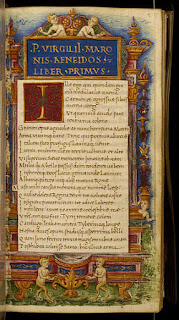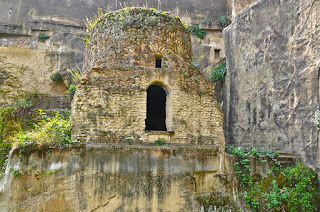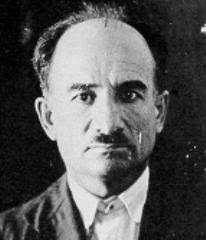Writer’s epic poem commemorates achievements and ideals of Rome
Regarded as the greatest of the Roman poets, Virgil, or Publius Vergilius Maro as he was originally named, was born on this day in 70 BC in the village of Andes near Mantua, in what is now Lombardy.
Virgil was held in high regard by the emperor
Augustus, to whom he read his work
Virgil is famous for his work, the Aeneid, which told the story of Rome’s founder and the Roman mission to civilise the world under divine guidance. It is widely considered one of the most important poems in the history of Western literature.
Experts have high regard for Virgil’s poetry, not only for the music and diction of his verse and for his skill in constructing an intricate work on a grand scale, but also because of what it reveals about Roman life and behaviour.
Virgil was born of peasant stock and his love of the Italian countryside and the people who worked in it is well reflected in his poetry.
He was educated in Cremona, Milan and Rome and acquired a thorough knowledge of Greek and Roman authors and was trained in rhetoric and philosophy.
When Virgil was 20, Julius Caesar crossed the Rubicon and began the series of civil wars that did not end until Augustus’s victory at Actium in 31 BC. Hatred and fear of civil war is powerfully expressed by Virgil in his poetry, to which he devoted his whole life.
 |
| A 3rd century Roman mosaic depicting Virgil with the muses Clio and Melpomene |
His earliest surviving work is the Eclogues, a collection of ten pastoral poems composed between 42 and 37 BC. They describe an imaginary world where shepherds sing in the sunshine about the simple joys of life.
But some of the poems refer to the real world, either directly or through allegory, which gave a new direction to the genre.
The fifth eclogue on the death of the king of the shepherds is thought to have some relationship with the death of Julius Caesar, which was still recent at the time it was written.
Virgil set out to embody his ideal Rome in the Aeneid by telling the story of the foundation of the first settlement in Italy, from which Rome was to spring, by an exiled Trojan prince, Aeneas.
He presented Aeneas as the prototype of the Roman way of life, the last of the Trojans and the first of the Romans. In describing the pictures on his shield, Virgil foreshadowed real events in Roman history.
 |
| A leaf from an 18th century manuscript of the Aeneid |
Virgil worked on the Aeneid for 11 years and had not finished its final revisions when he died in 19 BC.
He was on his way to Greece to do research for the revisions but caught a fever on the voyage and returned to Italy. He died soon after his arrival at Brundisium, modern day Brindisi in Puglia in southern Italy.
There is a story that Virgil’s dying wish was for his epic poem to be burned, but that this was countermanded by the order of Augustus, to whom Virgil had previously read extracts. Therefore the Aeneid survived to commemorate the achievements and ideals of Rome in the Augustan age and keep alive the sensitive voice of the poet himself.
Travel tip:
The parish church of Pietole, close
to where Virgil was born
According to legend, the birthplace of the Roman poet Virgil is the village of Andes, now called Pietole Vecchia, which is a short distance from the centre of Pietole in modern Virgilio. The comune - municipality - of Virgilio is cited as ‘Pietoli patria di Virgilio’ in the Gallery of Maps in the Vatican Museums. Modern day Virgilio is a frazione - hamlet - of the comune of Borgo Virgilio in the province of Mantua in Lombardy. It is about 130 km (81 miles) southeast of Milan and about six km (4 miles) south of Mantua.
Travel tip:
The tomb of Virgil, at the entrance to the
grotta vecchia in Piedigrotta, near Naples
Virgil’s tomb is at the entrance to an ancient Roman tunnel, ‘grotta vecchia’, in Piedigrotta, a district 3km (1.9 miles) from the centre of Naples, near Mergellina and Fuorigrotta, on the road heading north along the coast to Pozzuoli. The verse inscription at the tomb has been translated as: ‘Mantua gave me life, the Calabrians took it away, Naples holds me now, I sang of pastures farms and commanders.’ In the Middle Ages, Virgil’s name became associated with miraculous powers and his tomb was a destination for pilgrims. The poets Petrarch and Boccacio were among those who visited. At the time of Virgil’s death there was a large bay tree near the entrance, but according to a local legend, the tree died when Dante died, so Petrarch planted a new one in its place. However, visitors took branches from it as souvenirs and so the second tree died as well. The tomb remains a tourist attraction and still contains a tripod burner, which was originally dedicated to Apollo, but Virgil’s ashes were lost while being moved during the Middle Ages.
Also on this day:
1764: Edward Gibbon in Rome is inspired to write his ‘Decline and Fall’
1785: The birth of painter Giovanni Migliara
1905: The birth of footballer Angelo Schiavio, whose goal won Italy’s first World Cup
1964: The birth of astronaut Roberto Vittori




















